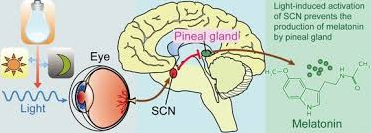Newsletter 34: The Silent Timekeeper: Why Pineal Gland Health Matters
In my previous newsletter, I wrote about the function and purpose of the Pineal Gland.
In this issue, we will focus on the conditions, disorders and the problem of the pineal gland.
Introduction:
The pineal gland regulates sleep through melatonin. Disorders like calcification, cysts, or tumors can cause sleep issues, mood changes, early puberty, or vision problems. Though small, its dysfunction affects hormonal and brain balance, making early detection important for maintaining overall well-being and the body’s internal clock.

🌲🧠 What conditions and disorders affect the pineal gland?
🌲🦠 Pineal gland tumors.
🌲💥 Pineal gland tumours are very rare, and there are several different types of them.
They’re more likely to affect children and adults younger than 40.
🌲🦠 Pineal tumors aren't always cancer, but they still cause problems as they grow because they press against other parts of your brain.
They can also block the normal flow of cerebrospinal fluid, which is the fluid that surrounds and cushions your brain.
This blockage raises the pressure inside your skull, which is dangerous and requires treatment.
🌲💥 Injuries that affect the pineal gland:
Damage to your pineal gland can cause it to work improperly.
Approximately 30% to 50% of people who experience a traumatic brain injury (TBI) have issues with at least one endocrine gland in their brain, which includes the pineal gland and pituitary gland.
🌲⚒️ A traumatic brain injury can happen when there is a blow to the head.
The injury can be penetrating, like a gunshot wound, or a non-penetrating injury, like being struck in the head during a car accident. Concussions are the most common type of TBI.
🌲😬 Pineal gland calcification:
Calcification of the pineal gland is quite common.
In fact, it’s so common that healthcare providers often use a calcified pineal gland as a landmark on x-rays to help identify different structures of the brain.
Calcification happens when calcium builds up in body tissue, causing the tissue to harden.
🌲🧠 Your pineal gland tends to calcify as you age.
While some calcification is normal, excessive calcification can prevent your pineal gland from functioning properly.
Some studies have revealed that the degree of calcification of the pineal gland is higher in those affected by Alzheimer’s disease.
There’s a loose link between pineal gland calcification and some migraine and cluster headaches.
🌲🤔 More studies need to be done to determine the exact effects of pineal gland calcification.
🤔❓ What are the symptoms of pineal gland problems?
If you have a pineal gland tumor, which are rare, you may experience the following symptoms:
💥🧠 Seizures.
💥🧠 Memory issues.
💥🧠 Headaches.
💥🤢 Nausea and vomiting.
💥👁️ Vision changes.
🔍❓ What are common tests to check the health of the pineal gland?
Healthcare providers can look at your pineal gland with imaging tests, such as an MRI (magnetic resonance imaging) or a CT (computed tomography) scan.
Providers use these imaging tests to help determine if you have a pineal tumour or cyst.
🔍❓ Providers may also use X-rays to check for pineal gland calcification.
🔍🧬 Your provider can also check your melatonin levels with a blood test.
💊 How are pineal gland conditions treated?
Medicinally, pineal gland tumours may be treated with one or more of the following therapies:
💉🔪 Surgery: Surgical removal of a pineal tumour is difficult due to its location in the middle of your brain.
Because of this, it’s not a common treatment. In some cases, a surgeon might remove the entire pineal gland (pinealectomy).
💥☢️ Radiation therapy: Radiation therapy focuses strong beams of energy to destroy cancer cells and prevent them from growing.
💊💉 Chemotherapy: Chemotherapy uses drugs to destroy cancer cells and prevent them from growing.
💊 If you have a condition that causes your pineal gland to secrete less-than-normal levels of melatonin, cell therapy is your best solution and is non invasive.
In conclusion:
Though often overlooked, the pineal gland plays a vital role in maintaining hormonal balance and healthy sleep patterns. Recognizing and addressing its disorders early can help prevent deeper neurological and hormonal issues, supporting overall well-being and a more balanced body rhythm.
